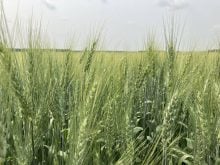Calcium may be the main ingredient in wood ash but that doesn’t mean that calcium is making soil more fertile, says a researcher at the Thunder Bay Agricultural Research Station. In actuality, it is the oxides in wood ash that improve soil fertility because those chemicals combine with hydrogen to increase the pH of acidic soils.
“When anything is burned, everything turns into oxide. Calcium turns into calcium oxide, potassium turns into potassium oxide and phosphorous turns into phosphorous oxide,” said Tarlok Singh Sahota, director of research at the Thunder Bay station.
Read Also

Agco worries about outlook for North America
Agco chief executive officer Eric Hansotia recently had both good and bad news to share about the demand for new farm equipment.
“When the oxides react with the excess hydrogen in the soil they will form water… so that means they will neutralize the soil…. So they (the oxides) lower soil pH. Not the calcium.”
Sahota knows what he’s talking about because he has studied the agronomic value of wood ash over the last seven years. Farmers around Thunder Bay have applied wood ash to their hay fields and crops for the last 15 years, because the soil in the region is naturally acidic.
The ash comes from the Abitibi Bowater pulp and paper mill in Thunder Bay, which delivers the product, free of charge, to farms in the region. The company provides the service because the alternative, dumping the material into municipal landfills, is costly.
Spreading lime may be a more conventional method to treat acidic soils around the world, but Sahota’s research has shown that wood ash offers additional agronomic benefits.
“Wood ash also improves the soil’s physical properties whereas lime cannot…. Its action is only chemical,” said Sahota, who noted that most of the dairy farmers, cattle and sheep producers around Thunder Bay apply wood ash to their fields.
“Wood ash has a lot of other nutrients, particularly the micronutrients –zinc, manganese, copper and boron.”
As well, the organic matter in the ash increases the organic matter within the soil, which in turn improves water retention.
Based on trials around Thunder Bay, Sahota has found alfalfa fields treated with wood ash changed the soil pH from 5.9 to 7.1. The wood ash fields in the trial yielded, over a three-year period, 15.5 tonnes of dry matter per acre, whereas fields treated with lime yielded 14.1 tonnes of dry matter per acre.
Furthermore, the fertility of the fields treated with wood ash declined more slowly over several harvests compared to the nutrient losses in lime treated fields.
The sustained availability of phosphorous and other nutrients is connected to the pH of the soil, Sahota said.
“Wood ash has some phosphorous in it but not in a significant amount,” he said. “(But) because of the improvement in the pH, the availability of phosphorous improves as well. The maximum availability of nutrients is when the pH is in the neutral range.”
While farmers across the border from Ontario, in Minnesota, also apply wood ash to their fields, Sahota isn’t sure if wood ash makes sense for farmers with acidic soils in other parts of Canada. Wood ash may be a superior product to lime but it only makes economic sense if the cost to transport the product is minimal.
“If farmers have to pay for the transport cost then they have to weigh how much lime will cost and how much wood ash will cost.”















